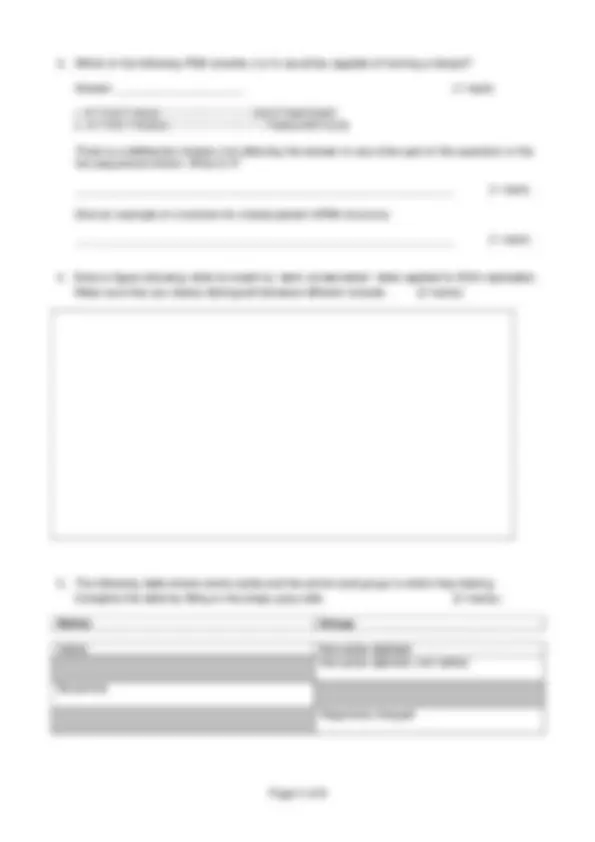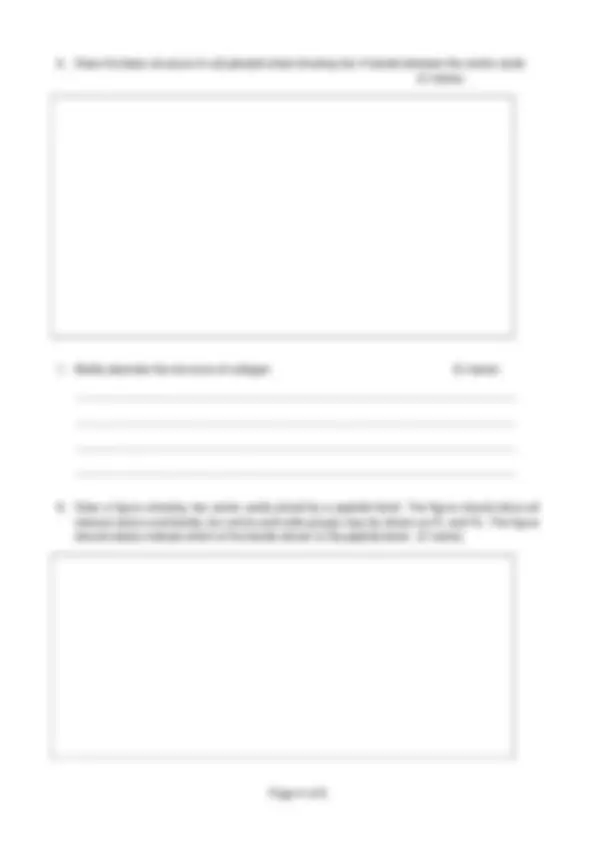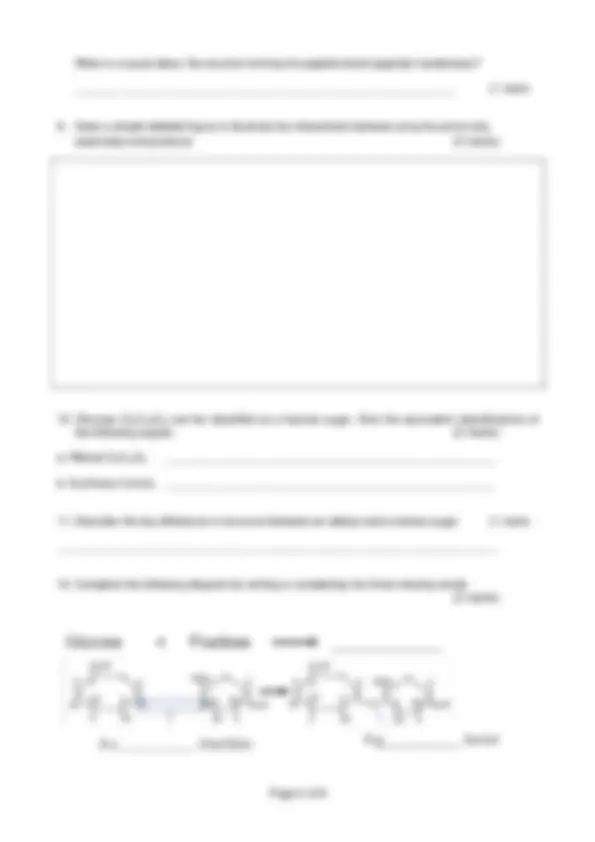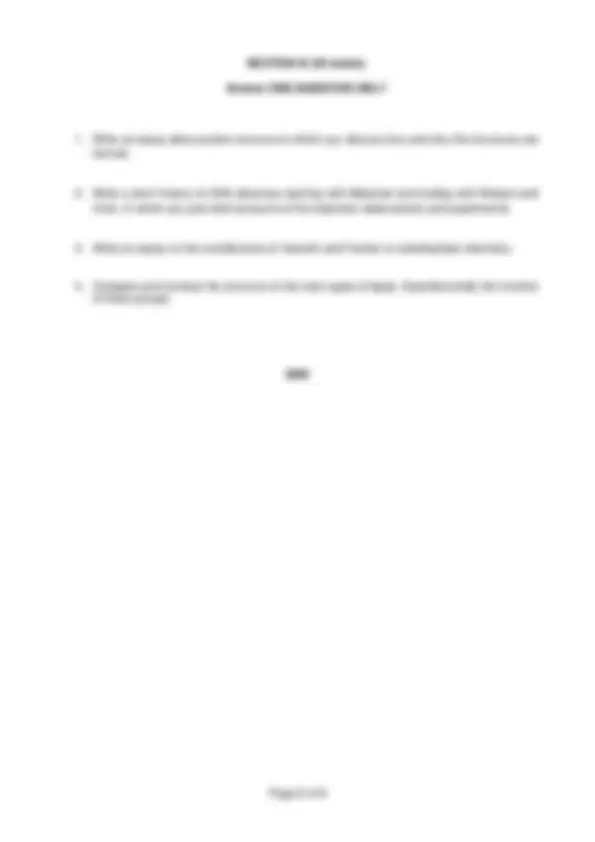Download Amino Acid Group - Biochemistry of Life - Exam and more Exams Biochemistry in PDF only on Docsity!
ARHOLIADAU EXAMINA TIONS
SEMESTER 1 EXAMINATIONS 2011
IBERS (BIOLOGICAL SCIENCES)
BS12910 BIOCHEMISTRY OF LIFE
TIME ALLOWED: TWO HOURS
ANSWER ALL QUESTIONS FROM SECTION A IN THE SPACE PROVIDED ON THE
QUESTION PAPER, AND ONE QUESTION FROM SECTION B IN THE SEPARATE ANSWER
BOOK
Rhif Cyfeirio‟r Myfyriwr/ Student Reference Number: ……………………………………………
Dyddiad/Date ………………………………………………
Ystafell Arholiad/Examination Room ………………………………………………
Rhif y Sedd/Seat Number ………………………………………………
- Rhowch y wybodaeth angenrheidiol yn y blychau uchod a rhowch eich enw yn y man gwag ar dop y tudalen ar y dde. Plygwch a seliwch y cornel ochr dde ar dop y tudalen (gan ddefnyddio‟r slip gludiog a ddarperir) er mwyn cuddio eich enw.
- Rhaid i‟r atebion fod wedi eu hysgrifennu‟n glir. Gall yr Arholwyr nail ai anwybyddu sgript annealladwy, neu drefnu i‟w theipio a chael yr ymgeisydd i gwrdd â chost y gwaith.
- Ysgrifennwch eich atebion mewn inc.
- Ni ddylid torri allan unrhyw ran o‟r llyfr hwn; rhaid ei ddychwelyd mewn ffurf gyflawn.
- Os ymadewch â‟r ystafell arholi yn gynnar, gwnewch hynny‟n dawel os gwelwch yn dda rhag aflonyddu ar ymgeiswyr eraill. 1. Please give the information requested above and enter your name in the space provided at the top right of this page. If your answers are to be marked under a scheme approved by the College whereby the examiners will not know your identity, fold over and seal down the top right-hand corner (using the gummed slip provided) in order to conceal your name. 2. The answers must be legibly written. The Examiners can either ignore illegible script or have it typed and the expense of typing charged to the candidate. 3. Write your answers in ink. 4. This paper must be handed in complete. 5. If you leave the examination early, please do so quietly so as not to disturb other candidates.
Fold over and stick down/plygwch y gornel drosodd
Cyfenw/Surname.............................................
Enwau Cyntaf/ Forenames ......................................................
........................................................................
SECTION A (50 marks)
- Sequences A and B below represent two DNA sequences. Which sequence will denature („melt‟) at the higher temperature?
___ _____________________________________________________________ (1 mark)
Sequence A C G G C G T C G G T C A C A G C C G C A G C C A G T G T
Sequence B C T A C T T A C A T A T C C G A T G A A T G T A T A G G
Briefly explain your answer (2 marks)
What are the features which distinguish B and Z forms of DNA? (2 marks)
B _ _____________________________________________________________ (1 mark)
Z _ _____________________________________________________________ (1 mark)
What type of DNA sequence is likely to give rise to the Z form?
___ _____________________________________________________________ (1 mark)
- The following table shows nucleotides and some of the roles they play in the cell. Complete the table by filling in the empty grey cells (3 marks).
Nucleotide Function
ATP Energy storage and exchange NAD
Signalling second messenger
Acyl group donor
- Draw the basic structure of a β-pleated sheet showing the H bonds between the amino acids (3 marks).
- Briefly describe the structure of collagen (3 marks)
- Draw a figure showing two amino acids joined by a peptide bond. The figure should show all relevant atoms and bonds, but amino acid side groups may be shown as R 1 and R 2. The figure should clearly indicate which of the bonds shown is the peptide bond. (2 marks)
What is unusual about the enzyme forming the peptide bond (peptidyl transferase)?
________________________________________________________________ (1 mark)
- Draw a simple labelled figure to illustrate the interactions between enzyme active site, substrates and products (3 marks)
- Glucose (C 6 H 12 O 6 ) can be classified as a hexose sugar. Give the equivalent classifications of the following sugars: (2 marks)
a. Ribose C 5 H 10 O 5 ________________________________________________________
b. Erythrose C 4 H 8 O 4 ________________________________________________________
- Describe the key difference in structure between an aldose and a ketose sugar (1 mark)
- Complete the following diagram by writing or completing the three missing words (3 marks)
- Why are triacylglycerols called the “electric blanket” of mammals? (1 mark)
- What type of lipid is a common constituent of natural membranes (1 mark)
- What type of lipid are esters of long-chain alcohols and long-chain fatty acids (1 mark)
- What group of biologically important substances are derived from a basic cholesterol (1 mark)
SECTION B (50 marks)
Answer ONE QUESTION ONLY
- Write an essay about protein structure in which you discuss how and why the structures are formed.
- Write a short history of DNA discovery starting with Meischer and ending with Watson and Crick, in which you give brief accounts of the important observations and experiments.
- Write an essay on the contributions of Haworth and Fischer to carbohydrate chemistry.
- Compare and contrast the structure of the main types of lipids. Describe briefly the function of those groups.
END
















